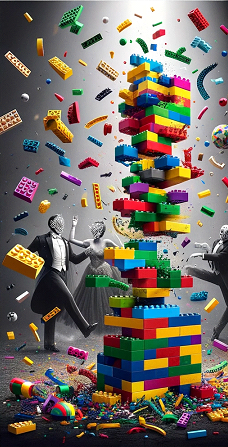Introduction: Recently, I found myself caught in a whirlwind of stress and anxiety, my mind racing with worries about the future. It was during this tumultuous time that I stumbled upon a simple yet profound realization: amidst life’s chaos, there is always something to be grateful for. Taking Time to Reflect: A Crucial Step in Navigating Life’s Transitions Life is a journey filled with moments of change and transition, each marking a shift in our path and presenting us with new opportunities for growth. Amidst these transitions, it’s essential to pause and take the time to reflect on our experiences, emotions, and goals. Self-reflection serves as a powerful tool for gaining clarity, understanding, and perspective as we navigate life’s twists and turns. The Power of Self-Reflection: In the hustle and bustle of daily life, it’s easy to get swept up in the whirlwind of activity and lose sight of our inner selves. However, carving out moments for self-reflection allows us to step back from the chaos and gain insight into our thoughts, feelings, and motivations. By examining our experiences with curiosity and openness, we can uncover valuable lessons, patterns, and opportunities for growth. Navigating Transitions with Intention: Transitions often prompt us to reevaluate our priorities, values, and aspirations, offering a chance to realign our lives with our true selves. Taking the time to reflect on the significance of the transition and its impact on our lives allows us to approach it with intention and purpose. By clarifying our goals and intentions, we can navigate the transition with greater clarity, confidence, and resilience. How to Practice Self-Reflection: Create Space: Set aside dedicated time and space for self-reflection, free from distractions and interruptions. Whether it’s through journaling, meditation, or simply quiet contemplation, find a practice that allows you to connect with your inner thoughts and feelings. Ask Questions: Challenge yourself to ask probing questions that encourage deep introspection and self-discovery. What are my fears and concerns about the transition? What opportunities does it present for growth and learning? What values and priorities do I want to prioritize moving forward? Listen to Your Inner Voice: Pay attention to your intuition and inner wisdom, trusting that it holds valuable insights and guidance. Tune into your emotions, sensations, and gut feelings, allowing them to inform your decisions and actions as you navigate the transition. How to Seek Support: Reach Out: Don’t hesitate to reach out to your support network and share your feelings and concerns about the transition. Whether it’s through a heartfelt conversation, a phone call, or a text message, expressing your thoughts and emotions can help lighten the burden and make you feel less alone in your journey. Be Specific: Clearly communicate what kind of support you need from others, whether it’s emotional support, practical assistance, or advice. By articulating your needs, you empower others to provide the support you require and ensure that your expectations are aligned. Accept Help: Be open to receiving help and support from others, even if it means stepping outside your comfort zone or relinquishing control. Remember that accepting support is not a sign of weakness but rather a testament to your strength and willingness to lean on others during challenging times. Practice Acceptance: Acknowledge that change is a natural part of life and that transitions, while sometimes challenging, offer opportunities for growth and self-discovery. Embrace the transition with an open mind and heart, allowing yourself to adapt to new circumstances. Seek Support: Don’t hesitate to reach out to friends, family, or professionals for support and guidance during times of transition. Surround yourself with a supportive network of people who can offer encouragement, empathy, and practical assistance as you navigate the change. Focus on What You Can Control: While some aspects of the transition may be beyond your control, focus on what you can control. Identify actionable steps you can take to navigate the transition more smoothly and proactively address any challenges that arise along the way. Practice Self-Care: Prioritize self-care during times of transition, taking care of your physical, emotional, and mental well-being. Engage in activities that bring you joy, relaxation, and fulfillment, and make time for rest, exercise, and nourishing your body and mind. The Power of Connection: In seeking support from others, we strengthen the bonds of connection that enrich our lives and sustain us through life’s ups and downs. By sharing our experiences, vulnerabilities, and triumphs with others, we foster a sense of community and belonging that reminds us we are not alone in our struggles. Navigating Transitions with Intention: Transitions often prompt us to reevaluate our priorities, values, and aspirations, offering a chance to realign our lives with our true selves. Taking the time to reflect on the significance of the transition and its impact on our lives allows us to approach it with intention and purpose. By clarifying our goals and intentions, we can navigate the transition with greater clarity, confidence, and resilience. The Transformative Power of Reflection: Self-reflection is not merely a passive act of introspection but a dynamic process of self-discovery and growth. By engaging in regular self-reflection, we cultivate greater self-awareness, resilience, and authenticity, enabling us to navigate life’s transitions with grace and confidence. Conclusion: As you navigate the transitions of life, remember the power of self-reflection as a guiding light on your journey. Taking the time to pause, ponder, and connect with your inner self allows you to navigate transitions with intention, clarity, and grace. Embrace the transformative power of reflection, and trust in its ability to illuminate your path and lead you towards a life of purpose, fulfillment, and authenticity. আমি এগিয়ে যাওয়ার জন্য কোন মূল্যবোধ এবং অগ্রাধিকারগুলিকে অগ্রাধিকার দিতে চাই?


